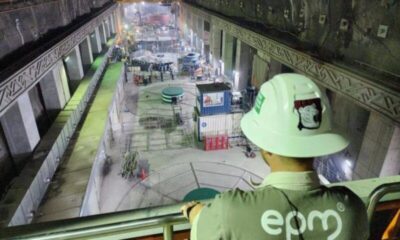Bridge Collapse on Bogotá-to-Villavicencio Route Kills at least Nine Workers in Colombia
At least nine people have died following the collapse of a 1,500-foot-long suspension bridge under construction in Colombia on the route between the cities of Bogotá and Villavicencio, public officials have confirmed.
Eight others were wounded by the catastrophic failure of the bridge in Chirajara that spanned a wide gorge, according to the National Disaster Risk Management System (UNGRD), which coordinated the search and rescue efforts.
Coviandes, the agency in charge of the large-scale project to revamp the roadway between the capital and the Los Llanos Orientales region, said that the injured have been taken to a hospital in Villavicencio, the capital of the department of Meta.
The agency confirmed that the nine people known to have died were subcontractors on the project working for two different companies, GISAICO S.A. and ICMO S.A.S.
At least 17 people were believed to have been working at the site of the tragedy, located around kilometer 64 along the route, per various reports.
The massive bridge, which had not yet been put into public service, was only 20 meters from being completed, said Colombian Transportation Minister Germán Cardona, who alongside Colombian President Juan Manuel Santos visited the bridge in late 2017.
Cardona traveled to the scene of the disaster today to aid the emergency response and said the government will do whatever it can to assist the families of the victims.
In addition to UNGRD personnel, firefighters and members of the military, Red Cross, National Infrastructure Agency, and local public agencies were among those at the scene helping with emergency response.

In November 2017, Colombian President Juan Manuel Santos visited the vast suspension bridge as it was nearing completion. (Photo credit: Presdencia de la República / César Carrión, SIG)
Coviandes said in a statement that it initiated its emergency response plan as soon as it became aware of the collapse. Some travel restrictions were quickly imposed on the route, including nearby the Naranjo toll road and Buenavista section.
Dimitri Zaninovich, head of National Infrastructure Agency (ANI), the Bogotá-based agency that oversees Colombia’s infrastructure system, traveled today to the site of the collapse. ANI said that it would release more information as it is known and that “efforts are focused on rescuing victims and caring for the injured.”
Santos, after learning more about the collapse, called for a thorough investigation into the type of catastrophe that he said “had never happened and cannot not happen again.”
He also has expressed remorse and condolences to the victims on behalf of the nation. “We are very sorry for this accident, and we express complete solidarity with the families of the workers who lost their lives and were injured,” said Santos.
ANI head Zaninovich said that his team of investigators has begun the process of trying to discover the cause of the fatal collapse. “That will take a few days, but we are urging for a swift response to this situation,” he said.
The bridge construction work and general overhaul on this route — known as the Concesión Vial de Los Andes — are a part of the country’s massive “4G” infrastructure program that is attracting billions of dollars in private/public partnership investments to improve Colombia’s transportation system.
During his November visit to the area, President Santos hailed the engineering feats underway on the Bogotá-to-Villavicencio route as a part of the nation’s “infrastructure revolution,” calling the works similar to what you might find in Switzerland, Germany, or the United States.
According to the office of the president, in a November 2017 statement, the work on this route was expected to be completed in March. In all, the efforts included eight bridges, five tunnels, and an investment of $540 billion Colombian pesos (around $180 million USD at the average exchange rate in 2017).
Photo: Colombian Transportation Minster German Cardona assesses the catastrophic bridge collapse that reportedly killed at least nine people. (Photo credit: Ministry of Transportation / MinTransporte)
This article has been updated as more information has developed following the collapse.

























